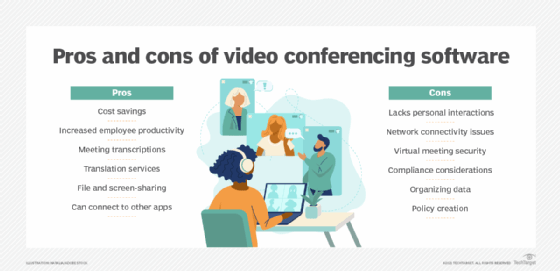12 advantages and disadvantages of video conferencing (original) (raw)
Video conferencing can help businesses save money and make employees more productive, but it can make personal connections difficult and requires more secure technology.
By
- Reda Chouffani,
- Michaela Goss, Senior Site Editor
Published: 07 Nov 2024
Remote and hybrid work are here to stay, and video conferencing software will remain commonplace.
Video conferencing software has evolved beyond traditional applications that connect two or more users through audio and video in real time. Organizations have various free options for video support, such as FaceTime, Skype and Facebook Messenger. Yet, free tools can't support all end users' communication requirements, including screen sharing, chat, file sharing, co-authoring and in-depth security and content control. Those requirements reduce the product options available, but some popular products include Microsoft Teams, Zoom, Webex, GoToMeeting and Google Meet.
Advantages of video conferencing software
When an organization selects unified communications software, it can see how a paid subscription can go past traditional video conferencing software and offer capabilities beyond video and audio.
Video conferencing software can benefit organizations in the following six ways.
1. Increased savings
Many organizations have significant annual budgets for travel to conferences, other businesses and branch offices. However, the COVID-19 pandemic in 2020 led organizations to meet with clients and hold conferences virtually, which video conferencing software enabled. Most organizations likely saved their entire travel budgets over this time and could choose to continue to travel less and save money in the future.
Additionally, platforms like Zoom offer free meetings for a limited number of users or a limited length of time, which could benefit small businesses that lack the budget to travel or invest in other video conferencing products.
2. Increased employee productivity
Video conferencing capabilities enable employees to work remotely -- whether from home, a coffee shop, a library or another location other than the office. This flexibility eliminates various time barriers, such as commute times or travel to and from conference rooms. Employees can join video conferences from anywhere. Also, these meetings become more accessible to employees with disabilities, employees in different states or time zones and potential new hires from different locations.
Employees don't have to wait for in-person meetings to discuss issues or ask questions, so they can accomplish tasks and solve problems quickly.
Video conference platforms can also improve communication between employees, as they enable users to discuss issues in real time with chat capabilities, file sharing and video calling. Employees don't have to wait for in-person meetings to discuss issues or ask questions, so they can accomplish tasks and solve problems quickly.
3. Meeting transcription services
Virtual meetings -- like sales product presentations, reviews of current financial performance, contract negotiations or employee reviews -- generally result in action items and next steps. Action items can include generating a quote to send to the client, or an employee making contract adjustments. The takeaways are generally handwritten or digital notes. Yet, with frequent virtual meetings due to remote working, employees may struggle to capture this information, especially if meetings have many attendees.
Many video conferencing platforms, including GoTo Meeting, Zoom and Microsoft Teams, offer meeting transcription features to prevent these issues. These features transcribe spoken word into text and provide the text to the meeting attendees. This feature can eliminate the need for an administrative assistant or an attendee to take notes and it adds a neutral party to capture the information. Businesses could also adopt generative AI tools to fill this need.
4. Translation services for multilingual meetings
Some meetings require folks across international borders to meet and interact virtually. In some of these calls, individuals who speak different languages may interact, which creates challenges when discussions arise. Organizations could hire translators -- which adds cost and complexity -- if existing employees aren't multilingual, or risk misinterpreting parts of the translation.
Organizations have various options to support multilingual meetings. Microsoft Teams and Skype offer the ability for anyone communicating over text to receive text translations. However, this may not suffice in video or audio calls. For those meetings, organizations can use features offered by vendors, like Microsoft's Azure Speech Translation services, or generative AI tools. These tools transcribe spoken words and translate them in real time for attendees to view or hear. This enables multilingual communication in meetings and captions for users who are hard of hearing.
5. File and screen-sharing capabilities
Modern video conferencing software also offers the ability to share content and a user's screen with one or more meeting attendees. Screen sharing has become critical, as employees require remote assistance at times from their team members.
Another use case is the need to present content, which requires users to display files or data to meeting attendees. Employees could also collaborate and work on shared documents together in real time or through screen sharing.
6. One-stop shop and the gateway to other apps
Platforms like Microsoft Teams offer users access to other apps within the video conferencing software. With this access, users don't have to leave the app to connect to tools such as a CRM system, Microsoft SharePoint or Microsoft Planner.
This approach may appeal to users who want to reduce switching between apps and have easy access to apps and services within the video conferencing tool.

The advantages and disadvantages of video conferencing software revolve around privacy, cost and content sharing capabilities.
Disadvantages of video conferencing software
Despite the many advantages of video conferencing software, these platforms still pose challenges to organizations, especially for content managers and compliance officers.
Video conferencing software raises the following six concerns.
1. Lack of personal interactions
Video conference meetings can feel impersonal. Even with video enabled, employees are simply communicating with screens. A lack of personal connections and face-to-face contact may cause employees to struggle to get to know their co-workers, managers or clients and develop personal connections with them.
2. Network connectivity issues
Office settings typically have reliable network connectivity, as well as backup options in case the Wi-Fi network goes down so employees still have an internet connection. Home networks rarely have backup options. These networks also weren't built to support the same activities -- including video conferencing -- as office networks, so they may fail due to bandwidth if, for example, multiple people are on video conferences simultaneously. Home networks may also cause lagging video or audio and dropped calls.
3. Securing meetings
In 2020, hackers took advantage of the boost in video conferencing usage and increased their attempts to infiltrate and disrupt meetings to create chaos. Zoom, in particular, faced scrutiny for several publicized meeting disruptions from internet trolls and caused many IT executives to worry about internal meetings' security.
After these incidents, security came more into focus. Many video conferencing apps have safeguards in place that ensure only authorized attendees can join private business meetings, such as the use of passwords to access meetings and waiting rooms, so guests aren't automatically allowed in a meeting without the organizers' approval. These features have helped address some major security concerns.
4. Complying with laws and regulations
From a compliance perspective, organizations worry that due to different state laws, recording some meetings may be illegal without all attendees' approval. To address that, Microsoft Teams and Zoom offer audible announcements to confirm the meeting is being recorded. This functionality is configurable.
Organizations must also contend with the issue of storing and archiving recorded content. Healthcare organizations, for example, must store patient data anywhere from seven to 12 years, depending on the case. Healthcare organizations must also store that data in a way that complies with HIPAA regulations.
5. Organizing newly created data
Newly generated content from recorded meetings introduces new challenges as organizations consolidate and classify information available to users. For example, some video recordings can be a part of training content, other recordings can be project reviews and others can be team huddles. Regardless of the content type, IT teams must plan and define data governance to ensure the information is secure and easily accessible when employees need it.
6. Creating policies
Content managers must plan around new content types and sources, including recorded video meetings from different video conference platforms. Content managers should create new sets of policies, then apply and implement those policies on the newly created video, audio and text files from the meetings.
Editor's note: This article was published in 2021 and was updated to reflect changes in video conferencing best practices.
Reda Chouffani runs a consulting practice he co-founded, Biz Technology Solutions Inc., and is CTO at New Charter Technologies. He is a technology consultant with a focus on healthcare and manufacturing, cloud expert and business intelligence architect who helps enterprises make the best use of technology.
Michaela Goss is senior site editor for TechTarget's Customer Experience and Content Management sites. She joined TechTarget as a writer and editor in 2018.
Next Steps
Business practices that could ease meeting fatigue
Meeting room hardware supports hybrid employee experience
 What do huddle rooms look like in a post-pandemic workplace?
What do huddle rooms look like in a post-pandemic workplace?  By: David Maldow
By: David Maldow  Microsoft Teams
Microsoft Teams  By: Scott Robinson
By: Scott Robinson  Telepresence vs. video conferencing: What's the difference?
Telepresence vs. video conferencing: What's the difference?  Tap collaboration devices for employee experience data
Tap collaboration devices for employee experience data  By: Beth Schultz
By: Beth Schultz